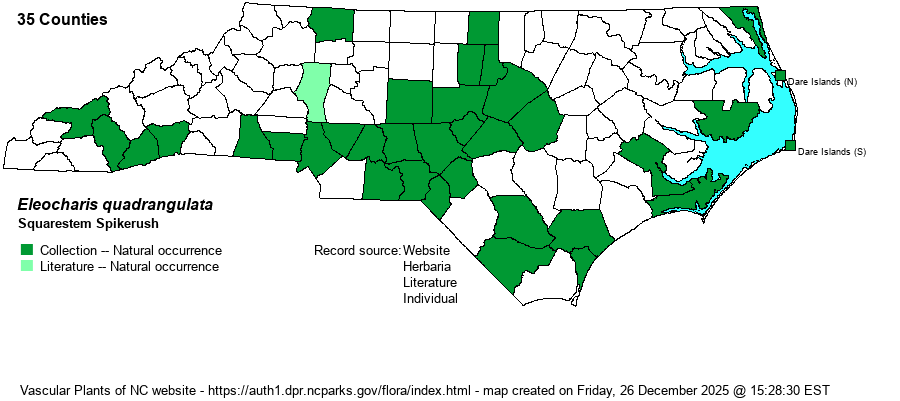| Author | (Michaux) Roemer & J.A. Schultes | |
| Distribution | In all regions of the state, but with large gaps in the northwest and northeast. As it ranges over all of southeastern VA, the northeastern NC gap appears to be an effect of lack of collection effort, whereas the gap in the northwest seems to be real.
MA to southern Ont. and MI, south to northern FL and TX. | |
| Abundance | Uncommon on the landscape, except rare on the Outer Banks. Can be fairly common in the central parts of the state. The current State Rank of S2 is far too conservative for a statewide plant; the editors suggest a rank of S4. | |
| Habitat | Ponds, lakes, reservoirs, marshes. |
| Phenology | Flowering and fruiting June-September. | |
| Identification | Along with E. equisetoides, this is our most robust spikerush, normally 2-3 feet tall. It differs in its 4-sided stem in cross-section (vs. rounded). It differs from E. cellulosa by its larger size and the 4-sided stems. | |
| Taxonomic Comments | None
The genus Eleocharis, the spikerushes, are unusual members of the sedge family in that the culms (flowering stems) are round or oval (rarely triangular) in cross-section, rather than triangular in the great majority of our sedges. In addition, leaf blades are absent; just 1-2 basal sheaths are present at the base of the culm. There is a single, cylindrical or narrowly ovoid, spikelet of florets at the culm summit. Details of achene (seed) shape, color, ornamentation, bristle length, and beak (tubercle) shape and size, are critical ID factors. | |
| Other Common Name(s) | Four-angled Spikerush | |
| State Rank | S2 [S4] | |
| Global Rank | G4 | |
| State Status | | |
| US Status | | |
| USACE-agcp | OBL link |
| USACE-emp | OBL link |

